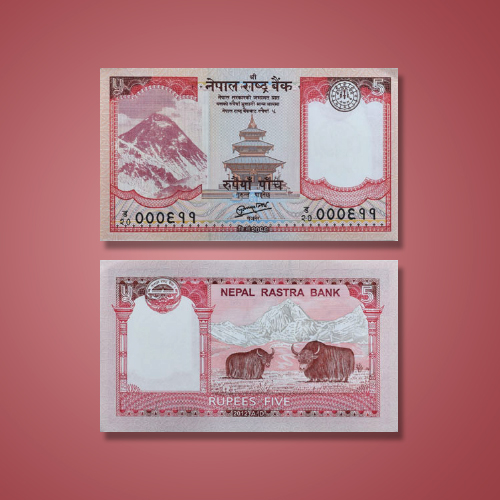Mount Everest & Kasthamandap Temple on Banknote
2022-01-11 Tue
Nepal introduced the rupee currency in 1932. They replaced the silver mohar at a rate of 2 mohar equal to 1 rupee. The currency is controlled and monitored by Nepal Rastra Bank. A 500-rupee note was issued on which the king’s portrait was replaced by Mount Everest in October 2007. This reflects the historic change from a kingdom to a republic which took place in May 2008 in Nepal.Further notes of 5, 10, 20, 50, 100 and 1000 rupees with Mount Everest and without reference to the king in their legends followed in 2008. The first issues of the 500- and 1000-rupee notes were printed on paper which still had the king's crowned portrait as a watermark in the "window" on the right part of the face of the notes. It was decided to print a red Rhododendron flower (Nepal's national flower) on top of the watermark.
2009 series notes are printed on paper that has a Rhododendron flower as a watermark instead of the royal portrait and were therefore released without the additional overprint in red. The pink-colored Rs5 bill is Nepal’s lowest value banknote. On the obverse side, it has the image of Mount Everest and a temple. The backside of the 5 rupee note shows two yaks on the 2012 series.
Disclaimer: Due to the latest government guideline, deliveries may take a little longer time than usual.
Latest News
-
Panchala King Bhanumitra Copper Coin
2024-04-26 FriThe Panchala kingdom was ruled by the Mitra kings. The Mitra kings are known to issue coins and most...
-
Mahatma
2024-04-25 ThuIndia Post issued a commemorative postage stamp on #LalaHansraj, also known as Mahatma Hansraj for�...
-
Berar Mint of Muhammad Akbar
2024-04-25 ThuBerar was a kingdom located in the Deccan region, with Elichpur as its capital. It was one of the Su...
-
Janma Kalnayak of Bhagwan Mahavir
2024-04-24 WedOn 21st April 2024 which was the 2550th Janma Kalnyanak of Bhagwan Mahavir Swami, PM Modi unveile...
-
Gold Pagoda of Vijaynagar Empire King Deva Raya I
2024-04-10 WedKing Deva Raya I of the Vijayanagara Empire was a patron of Kannada literature and architecture. He ...

